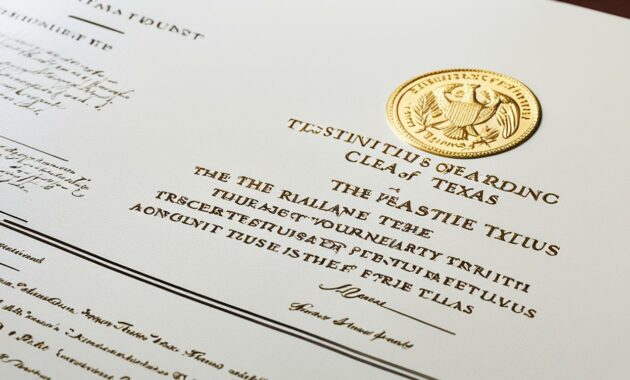In Texas, a living trust is a key part of estate planning. It helps people control their assets while alive. Plus, it makes passing on these assets easier when they die. This process avoids the long and costly probate steps. Living trusts in Texas come in two main types: revocable and irrevocable. They offer many benefits. These include keeping your dealings private, protecting assets, and allowing for easier asset control and handover. Yet, making a living trust in Texas requires knowing the law, the players, and the possible tax issues.
This in-depth guide will look closely at living trusts in Texas. It will cover revocable and irrevocable trusts, the important roles, plus the pluses and minuses. We’ll also walk you through making a living trust in the state. Whether you live in Texas or work in law, this guide is full of tips to use this strong estate planning method.
Understanding Living Trusts in Texas
There are two main kinds of living trusts in Texas: revocable and irrevocable. A revocable living trust can be changed by the person who made it. But an irrevocable living trust cannot be altered once it’s set up. This means the person who made it gives up some control.
Revocable vs. Irrevocable Living Trusts
In a revocable living trust, the maker can make changes or cancel it anytime. This gives them more freedom but less protection for their stuff. An irrevocable trust is more secure. Here, the maker gives up keeping and controlling the trust’s things. This choice could help protect the stuff from bills or taxes.
Roles Involved in a Living Trust
Three main roles are in a Texas living trust: the settlor, the trustee, and the beneficiary. The settlor is the person who makes and adds stuff to the trust. The trustee manages what’s in the trust and gives it to who the maker said, the beneficiary.
Understanding living trusts is key to smart estate planning in Texas. Knowing the differences between revocable and irrevocable trusts, and the roles involved, helps people meet their planning goals.
| Living Trust Type | Grantor Control | Asset Protection |
|---|---|---|
| Revocable Living Trust | Grantor retains full control | Provides limited asset protection |
| Irrevocable Living Trust | Grantor relinquishes control | Offers enhanced asset protection from creditors and estate taxes |
“A living trust in Texas can be a valuable estate planning tool, allowing individuals to maintain control over their assets during their lifetime and ensure a smooth transfer of wealth to their loved ones after their passing.”
Benefits and Drawbacks of Living Trusts
Living trusts in Texas can really help, but they have their challenges too. It’s key to know what the good and not-so-good parts are. That way, you can decide wisely if this estate planning tool fits your needs.
Benefits of a Living Trust
Living trusts in Texas offer a big plus: they skip the long and costly probate process. When you put your stuff in a trust, it can go straight to your loved ones. And this means more savings for them.
Keeping things private is another bonus. Unlike with a will, your trust’s details stay between you and your trustee. No one else needs to know, even after you’re gone.
Living trusts give you a lot of control over your things. You can tweak the trust as you see fit. This makes sure your plans keep up with your life’s changes.
Downsides of a Living Trust
However, setting up a trust can be more expensive and time-consuming than a will. You need to set up a special account and move your assets over. But this may be a minor inconvenience for many.
There’s also the chance of more legal fights. Because a trust is private, it might spark problems among your family or friends. These arguments could slow down how fast your assets get divided up.
Taking into account all the good and bad of a living trust in Texas is crucial. It helps you see if it matches your wishes. Talking to an estate planning lawyer can guide you to the best choice.
Creating a Living Trust Texas: Step-by-Step Process
Starting a living trust in Texas is easy. It ensures your belongings are handled and given out as you want. The first thing to do is to write a trust document. This document needs to follow Texas laws. It should show you want to make the trust, can move your things into it, and follow the law about writing things down.
With the document ready, the next step is to put your things into the trust. You might need to change the name on your documents. This is for things like land, bank accounts, and special items. You should also give a copy of the trust to everyone named in it. This is very important.
To get a living trust in Texas, it can cost between $950 and $2,500. How much it costs depends on how big your estate is. You don’t have to use a lawyer, but it’s a good idea. They can help make sure everything is done right. Plus, they can make your wishes very clear.
Moving your stuff into a living trust Texas has good points. It skips the public probate step. You keep control of your things and can change the trust if your life changes. By understanding what Texas needs, you can make a plan that keeps your money safe for your family.

“A living trust in Texas offers a flexible and private way to manage your assets during your lifetime and beyond. It’s an essential component of a well-rounded estate plan.”
– Attorney Scott Steinbach
Drafting the Trust Document
Making a living trust document in Texas is key. It should name a trustee and who gets what. Plus, say how the trust’s stuff is used or given out.
Notarization isn’t a must in Texas but it’s wise, especially for trusts with property. Notarizing the living trust makes it hard to argue against later. It gives more legal safety.
It’s wise to talk to a Texas estate attorney when writing a living trust. They ensure it fits all living trust requirements and your needs. A good trust helps skip probate, keeps things private, and moves your stuff to who you choose easily.

“A living trust is strong for estate planning. But, getting the paperwork right is vital. With a good lawyer, you can handle Texas’ living trust requirements and make a trust that fits you perfectly.”
Transferring Assets into the Trust
After making your living trust document, the next big step is to put your things into the trust. This includes your house, money accounts, bank accounts, and belongings. It’s key to do this right so your trust works well and gives the benefits you want.
Transferring real estate to living trust Texas means signing a deed. This deed moves your property’s ownership to the trust. Then, you record this deed with the county. Now, the real estate is handled by the trust, not you personally.
To switch over financial accounts, like transferring bank accounts to living trust Texas, change the name on them to the trust. This takes them out of your name and puts them in the trust’s control.
For things like jewelry, art, or collectibles, you can transferring personal property to living trust Texas. Just use a document to say the trust owns these items.
| Asset Type | Transferring Process | Potential Considerations |
|---|---|---|
| Real Estate | Sign a deed transferring ownership to the trust, then record it with the county | Notify mortgage lender, update homeowner’s insurance, and maintain documentation of the transfer |
| Bank Accounts | Change account ownership to the trust’s name | Inform the financial institution and provide the trust documentation |
| Personal Property | Execute a general transfer document declaring the property as owned by the trust | Maintain a detailed inventory of the transferred assets |
Moving assets into your trust is a big part of planning your estate. By handling your house, money, and belongings properly, you protect and manage your things the way you want.
“Proper asset transfer is the foundation of an effective living trust. It’s the key to unlocking the benefits and ensuring your estate plan functions as intended.”
Working with a good estate planning lawyer can make this process easier. They help you follow the law when you fund your trust. With their help, you can make sure your family’s future is safe and secure.
Tax Implications of Living Trusts in Texas
Setting up a living trust in Texas means knowing its tax effects. Here, the state doesn’t have inheritance or estate taxes. But, people might face federal estate taxes.
Federal Estate Tax Implications
By 2023, the allowed amount before federal tax is $12.92 million for individuals, $25.84 million for couples. Those under these limits usually won’t owe estate taxes. Yet, for wealthier estates, a 40% tax rate applies.
To cut down on estate tax, one can gift assets, set up a marital trust, or use a unified credit. Talking with a tax pro is smart for choosing the best moves.
State-Level Tax Considerations
Texas taxes the income from a living trust’s assets. This covers earnings like dividends, interest, or capital gains. Not having state inheritance or estate taxes is a win for Texas residents.
The tax situation with living trusts in Texas is complex. Getting help from an estate planning lawyer or tax expert is wise. They can ensure the trust is set up to save on taxes.
Maintaining and Updating Your Living Trust
Keeping your living trust in Texas up to date is very important. This makes sure it works well and does what you want. You should update your trust as things in your life change. This is called updating living trust Texas. You need to get a trust amendment form, fill it out, add it to your trust, and tell the trustee about the changes.
Check and update your living trust in Texas every few years or after big life events. This could be after getting married, having a baby, or getting new things. Doing this keeps your trust in line with what you want for your estate and family.
When you update your living trust, be sure to let the trustee know. Give them a copy of the new trust document. This makes sure they can handle your trust as you wish.
“Maintaining a living trust in Texas is an ongoing process, but it’s essential to ensure your wishes are honored and your estate is protected.”
Be watchful and make the changes needed in your living trust. This will help make sure everything is managed as you want, no matter how life changes.
Living Trust Texas: Deciding if it’s Right for You
Setting up a living trust in Texas is something you choose to do. People see its benefits, like skipping the probate and keeping things private. It’s great for large or complicated estates because probate without a trust can be slow and expensive.
Yet, you should think about the downsides too, like the costs and not being able to name guardians for kids. To figure out if a trust matches your estate planning needs, think about your estate’s size and complexity. Also, consider your want for privacy and your goals for planning your estate.
For some, simple options are enough to avoid probate and move assets easily, such as joint tenancy or naming beneficiaries. Sometimes, the probate rules in Texas are easy enough, making a trust not essential. But, it’s smart to talk to a lawyer who knows estate planning. They can make sure your plan fits your situation and goals well.

